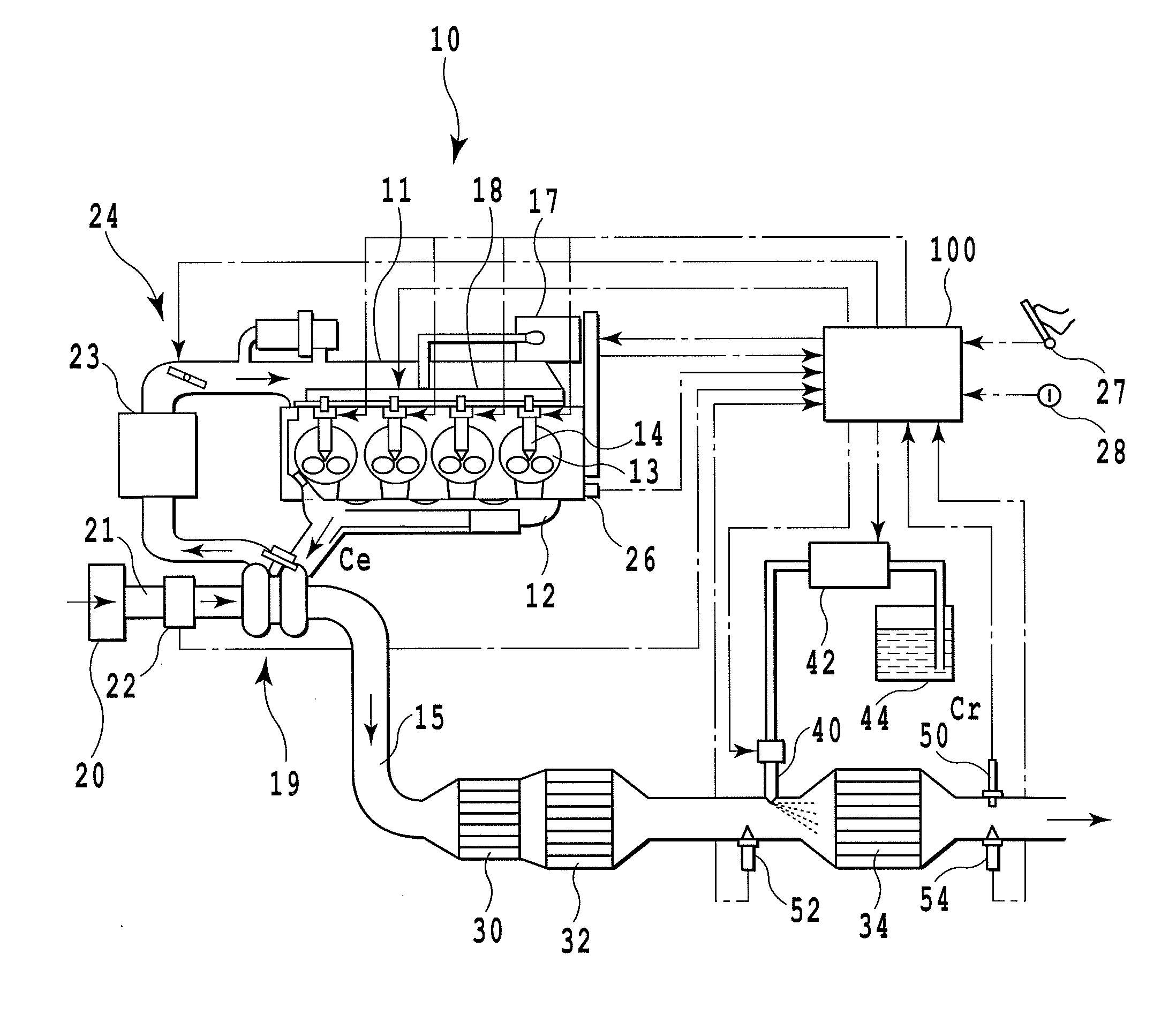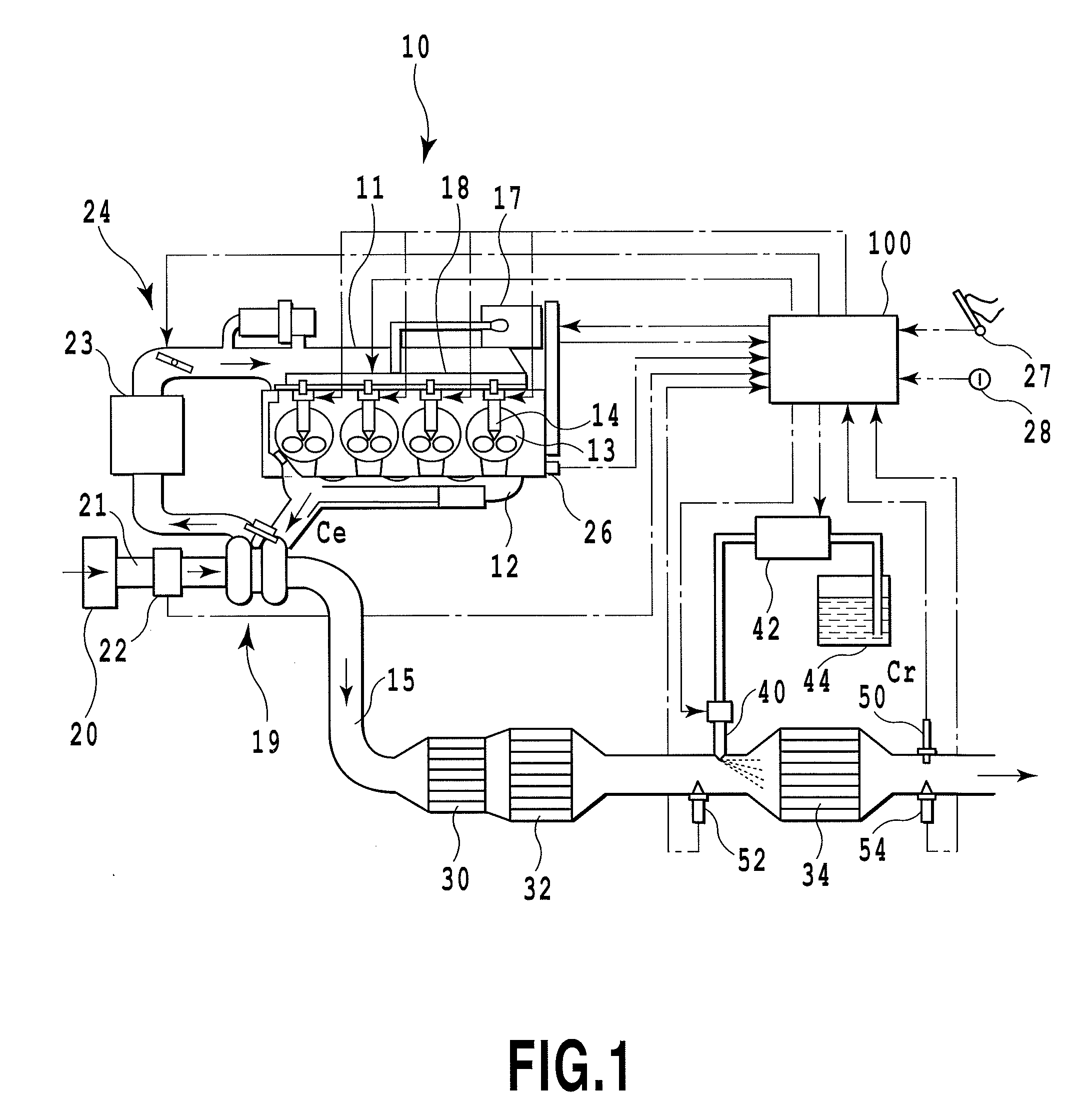ABNORMALITY DIAGNOSIS APPARATUS AND ABNORMALITY DIAGNOSIS METHOD FOR NOx SENSOR
a technology of nox sensor and abnormal diagnosis apparatus, which is applied in the direction of electrical control, instruments, machines/engines, etc., can solve the problems of inability to provide an on-board diagnosis, inability to find effective techniques, and high cost of cases
- Summary
- Abstract
- Description
- Claims
- Application Information
AI Technical Summary
Benefits of technology
Problems solved by technology
Method used
Image
Examples
first embodiment
[0092]FIG. 2 shows the abnormality diagnosis processing. The shown routine is repeatedly carried out by the ECU 100 with a predetermined cycle (e.g., 16 msec).
[0093]In the first step S101, whether predetermined conditions suitable for performing the abnormality diagnosis of the after-catalyst NOx sensor 50 are established or not is determined. For example, when all conditions of (a) the after-catalyst NOx sensor 50 reaches an active temperature, (b) the engine 10 is in a steady operation condition, and (c) the warm-up operation of the engine 10 is completed are satisfied, it means that the conditions are established. It is noted that, regarding the condition (b), the engine 10 can be recognized as being in a steady operation when a variation amount of the intake air amount detected by the air flowmeter 22 for example is within fixed values. Another condition (d) where the NOx catalyst 34 has a catalyst temperature equal to or higher than a predetermined minimum active temperature (e...
second embodiment
[0102]Next, the following section will describe abnormality diagnosis processing with reference to FIG. 3. The routine shown in FIG. 3 is also repeatedly executed by the ECU 100 at every predetermined cycle (e.g., 16 msec).
[0103]In the first step S201, it is determined whether predetermined conditions suitable for performing the abnormality diagnosis for the after-catalyst NOx sensor 50 are established or not. The conditions here are different from those in the step S101 in that the two conditions of the condition (a) in which the after-catalyst NOx sensor 50 reaches an active temperature and the condition (b) in which the engine 10 is in an steady operation condition are established for example. When it is determined that the predetermined conditions are not established, this routine is completed.
[0104]When the predetermined conditions are established on the other hand, it is determined in the step S202 whether urea addition is being stopped or not. The stoppage operation is a stop...
third embodiment
[0108]Next, the following section will describe the abnormality diagnosis processing with reference to FIG. 4. The routine shown in FIG. 4 is also repeatedly executed by the ECU 100 at every predetermined cycle (e.g., 16 msec).
[0109]In the first step S301, whether predetermined conditions suitable for performing the abnormality diagnosis of the after-catalyst NOx sensor 50 are established or not is determined as in the step S101. When it is determined that the predetermined conditions are not established, this routine is completed.
[0110]When it is determined that the predetermined conditions are established on the other hand, it is determined in the step S302 whether the current engine operating condition is an idling operation or not.
[0111]Specifically, if urea addition is stopped for abnormality diagnosis, the NOx catalyst 34 cannot reduce NOx and NOx is discharged to the downstream side of the NOx catalyst 34, thus undesirably causing a deteriorated emission. However, during an i...
PUM
 Login to View More
Login to View More Abstract
Description
Claims
Application Information
 Login to View More
Login to View More - R&D
- Intellectual Property
- Life Sciences
- Materials
- Tech Scout
- Unparalleled Data Quality
- Higher Quality Content
- 60% Fewer Hallucinations
Browse by: Latest US Patents, China's latest patents, Technical Efficacy Thesaurus, Application Domain, Technology Topic, Popular Technical Reports.
© 2025 PatSnap. All rights reserved.Legal|Privacy policy|Modern Slavery Act Transparency Statement|Sitemap|About US| Contact US: help@patsnap.com



